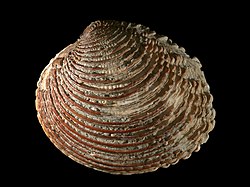Subfamily
Callocardiinae Dall, 1895- Agriopoma Dall, 1902
- Amiantis P. P. Carpenter, 1864
- Aphrodora Jukes-Browne, 1914
- † Austrocallista S. Erdmann & Morra, 1985
- Callista Poli, 1791
- Callocardia A. Adams, 1864
- Callpita M. Huber, 2010
- Costellipitar Habe, 1951
- † Dollfusia Cossmann, 1886
- † Dosiniopsis Conrad 1864
- † Eocallista Douvillé, 1921
- Eucallista Dall, 1902
- Ezocallista Kira, 1959
- † Goshoraia Tamura, 1977
- Hyphantosoma Dall, 1902
- Hysteroconcha Dall, 1902
- Lamelliconcha Dall, 1902
- Lioconcha Mörch, 1853
- Macrocallista Meek, 1876
- † Marwickia Finlay, 1930
- Megapitaria U. S. Grant & Gale, 1931
- Notocallista Iredale, 1924
- Nutricola F. R. Bernard, 1982
- Pelecyora Dall, 1902
- Pitar Römer, 1857
- Pitarenus Rehder & Abbott, 1951
- Proteopitar Alvarez, del Río & Martínez, 2019
- † Rohea Marwick, 1938
- Saxidomus Conrad, 1837
- Transennella Dall, 1884
- Transenpitar Fischer-Piette & Testud, 1967
- Veneriglossa Dall, 1886
Subfamily Clementiinae Frizzell, 1936
Subfamily Cyclininae Frizzell, 1936
Subfamily Dosiniinae Deshayes, 1853
Subfamily Gemminae Dall, 1895
Subfamily Gouldiinae Stewart, 1930
- Circe Schumacher, 1817
- Circenita Jousseaume, 1888
- Comus L. R. Cox, 1930
- Dorisca Dall, Bartsch & Rehder, 1938
- Gafrarium Röding, 1798
- Gouldia C. B. Adams, 1847
- Gouldiopa Iredale, 1924
- Laevicirce Habe, 1951
- Microcirce Habe, 1951
- Parvicirce Cosel, 1995
- Privigna Dall, Bartsch & Rehder, 1938
- Redicirce Iredale, 1936
Subfamily Meretricinae Gray, 1847
Subfamily Petricolinae d'Orbigny, 1840
Subfamily Samarangiinae Keen, 1969
Subfamily Sunettinae Stoliczka, 1870
Subfamily Tapetinae Gray, 1851
- † Adelfia M. J. Alvarez & del Río, 2020
- † Atamarcia Marwick, 1927
- Cryptonema Jukes-Browne, 1914
- † Cyclorismina Marwick, 1927
- Eumarcia Iredale, 1924
- † Gomphomarcia Kautsky, 1929
- Irus F. C. Schmidt, 1818
- Irusella Hertlein & U. S. Grant, 1972
- Katelysia Römer, 1857
- † Legumen Conrad, 1858
- Liocyma Dall, 1870
- Macridiscus Dall, 1902
- Marcia H. Adams & A. Adams, 1857
- † Marciachlys M. J. Alvarez & del Río, 2020
- † Myrsopsis Sacco, 1900
- † Neovenerella Goncharova, 1986
- † Paleomarcia Fletcher, 1938
- Paphia Röding, 1798
- Paratapes Stoliczka, 1870
- Polititapes Chiamenti, 1900
- Protapes Dall, 1902
- Ruditapes Chiamenti, 1900
- Tapes Megerle von Mühlfeld, 1811
- † Taurotapes Sacco, 1900
- † Venerella Cossmann, 1886
- † Veneritapes Cossmann, 1886
- Venerupis Lamarck, 1818
Subfamily Turtoniinae Clark, 1855
Subfamily Venerinae Rafinesque, 1815
- Ameghinomya Ihering, 1907
- Anomalocardia Schumacher, 1817
- Anomalodiscus Dall, 1902
- Antigona Schumacher, 1817
- Austrovenus Finlay, 1926
- Bassina Jukes-Browne, 1914
- Callithaca Dall, 1902
- Chamelea Mörch, 1853
- Chione Megerle von Mühlfeld, 1811
- Chioneryx Iredale, 1924
- Chionista Keen, 1958
- Chionopsis Olsson, 1932
- Circomphalus Mörch, 1853
- Clausinella Gray, 1851
- Dosina J. E. Gray, 1835
- Eurhomalea Cossmann, 1920
- Globivenus Coen, 1934
- † Hinemoana Marwick, 1927
- Humilaria U. S. Grant & Gale, 1931
- Iliochione Olsson, 1961
- † Kuia Marwick, 1927
- Leukoma E. Römer, 1857
- Lirophora Conrad, 1863
- † Marama Marwick, 1927
- Mercenaria Schumacher, 1817
- Panchione Olsson, 1964
- Paphonotia Hertlein & A. M. Strong, 1948
- Periglypta Jukes-Browne, 1914
- Placamen Iredale, 1925
- Protocallithaca Nomura, 1937
- Proxichione Iredale, 1929
- Retrotapes del Rio, 1997
- Tawera Marwick, 1927
- Timoclea T. Brown, 1827
- † Turia Marwick, 1927
- Venus Linnaeus, 1758
Incertae sedis
- † Aphrodina Conrad, 1869
- † Austrocardilanx R. N. Gardner, 2005
- † Callistina Jukes-Browne, 1908
- † Ergenica Goncharova, 1981
- † Frigichione Fletcher, 1938
- † Katherinella Tegland, 1929
- † Loxo Dailey & Popenoe, 1966
- † Meroena Jukes-Browne, 1908
- † Psathura Deshayes, 1858
- † Pseudamiantis Kuroda, 1933
- † Rzehakia Korobkov, 1954
- † Trigonocallista Rennie, 1930
- † Urbnisia Goncharova, 1981












